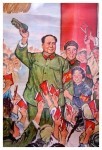Mao Zedong or Mao Tse-tung (1893-1976) was a Chinese revolutionary, political philosopher and national leader. He became the leader of communist China and one of the most significant leaders of the Cold War. Born into a peasant family in rural Hunan, Mao was a capable student who later obtained work as a librarian and a teacher. In 1921 Mao became a founding member of the Chinese Communist Party (CCP), attending its first meeting in Shanghai. During the 1920s he worked as a party official in Shanghai and regional party organiser in his native Hunan. In 1927 Mao led the Autumn Harvest Uprising, an unsuccessful peasant rebellion in Hunan. Two years later he set up a ‘peasant soviet’ – a self-sufficient agricultural collective, based on socialist principles – in the southern province of Jiangxi. The Jiangxi Soviet was a success but Mao’s control of it ended after CCP leaders relocated there in 1931. In 1934 government forces hostile to the CCP surrounded Jiangxi and forced the communists to retreat north. This retreat was the starting point of what became known as the Long March.
Mao’s leadership during the Long March (1934-35) and the Yan’an Soviet (1936-1949) increased his prominence and support in the CCP. By the mid-1940s Mao had emerged as the party’s political, military and ideological leader – though not without some bloodshed and persecution of his rivals. Mao’s political writings, later dubbed Maoism or ‘Mao Zedong Thought’. would come to form the official ideology of the CCP. Mao led the CCP’s Red Army against the Japanese during World War II, before turning his attention to the Nationalist government during the Chinese Civil War (1946-49). By October 1949 the Nationalists were in retreat and Mao proclaimed the formation of the People’s Republic of China. This communist victory reoriented the Cold War, moving its focus away from Berlin and western Europe and toward Asia. For the next three decades, the United States refused to recognise Mao, his party or their government. For Mao, who viewed America as a nation of aggressive imperialists, “the most murderous of hangmen”, this was not a concern.
Mao’s relationship with the Soviet Union was more important but was problematic. In late 1949 Mao traveled to Moscow to meet Joseph Stalin. As a fellow communist who now ruled the world’s most populous nation, Mao expected Stalin to welcome him as an equal. Instead, the Soviet dictator treated Mao as a junior partner, while criticising the progress of communism in China. Mao signed a treaty with the Soviets and later adopted some of Stalin’s economic policies, however, he considered China a unique place that required a “different road”. In the late 1950s the rise of a new Soviet leader, Nikita Khrushchev, increased tensions between the two communist powers and gave rise to the Sino-Soviet split (1960-69).
Domestically, Mao hoped to transform China from an undeveloped agricultural economy into an industrial and military superpower. The pace at which he attempted these reforms had a devastating impact on the Chinese people. In the mid-1950s Mao implemented a Soviet-style economic program, the First Five Year Plan, which involved collectivising peasant land into huge communes. This program achieved significant results and industrial growth – but it was not enough for Mao. In 1958 the Chinese leader launched his second Five Year Plan, dubbed the Great Leap Forward, demanding that heavy industries and steel production outgrow those of Western nations. Mao’s ambitious plans produced industrial growth but at enormous human cost, contributing to a famine that killed between 20 and 30 million people. Mao’s policies were sharply criticised by some of his colleagues, who urged a more moderate approach. Under pressure, Mao resigned the presidency of the People’s Republic of China (April 1959) and reluctantly stepped back from matters of government and policy.

In the mid-1960s Mao launched a campaign to identify and purge anti-socialist ideas from Chinese academia, art and literature. The Cultural Revolution, as it became known, grew into a sweeping social and political movement, based on one of the strongest personality cults in history. Driven by political radicals, mostly students fanatically loyal to Mao, the Cultural Revolution caused significant political and economic disruption, with years of purges, recriminations, public humiliations, show trials, beatings and murders. It restored Mao’s prestige and helped him regain control of the CCP and the national government. In March 1969 the Sino-Soviet split reached its most dangerous point with the outbreak of border war between the two powers. This conflict saw sporadic fighting over a six month period, with several hundred Chinese soldiers killed. In 1971-72 Mao opened the doors for rapprochement with the United States, allowing an American table tennis team to tour China, then agreeing to a visit from US Secretary of State Henry Kissinger. US-China relations were restored in 1972 following a state visit to Beijing by president Richard Nixon. The final years of Mao’s reign were marked by illness and incapacity. Mao died in September 1976, bringing about a tidal wave of grief and sorrow around China.
Content on this page is © Alpha History 2018. This content may not be republished or distributed without permission. For more information please refer to our Terms of Use.
This page was written by Jennifer Llewellyn and Steve Thompson. To reference this page, use the following citation:
J. Llewellyn & S. Thompson, “Mao Zedong”, Alpha History, accessed [today’s date], https://alphahistory.com/coldwar/mao-zedong/.
